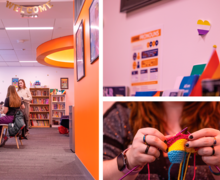The new Veo scooters pose potential risks
Megan Jonas | Contributing Photographer
The addition of Veo scooters on SU’s campus promotes drunk scootering and disregards how walkable Syracuse is.
A group of electronic scooters and bikes have popped up around the Syracuse area and Syracuse University’s campus over the past month. This development is courtesy of Veo, a company founded in 2017 with the mission of providing more environmentally friendly means of transportation to urban communities.
Veo has deployed its “fleet” of rides in about 30 locations across the country, particularly areas with colleges. Although I can’t speak for every university, I believe that in SU’s case, the introduction of this technology poses a much larger risk than reward.
The most pressing threat that the scooters and bikes pose is drunk scootering. Despite being illegal to do so, many people may still choose to operate scooters while under the influence. The vast accessibility of these rides make the ability to hop on while intoxicated quite easy. On a college campus, this ease could create some dangerous situations.
Beyond any accident involving a larger vehicle, someone who has consumed alcohol on an electric scooter could be prone to minor accidents that still run the risk of injury. Inhibitions are lowered when students are drinking, and adding in scooters that can go up to 15 mph, it seems like a recipe for trouble.
Another key point of emphasis is that SU is one of the snowiest colleges in America. We haven’t even seen the full effect of Veo’s rides on campus this spring, so as Syracuse eventually returns to its regular, frigid temperatures, the possible negative outcomes are even more likely. Slicker roads and sidewalks are not a good combo with college students scootering.
This potential disaster is all the more treacherous when considering that helmets are not provided with the scooter rides. Inebriated students already have liquid courage and a teenage god complex, so it makes having virtually no protection while scootering a huge liability.
In addition to this, Veo doesn’t have some of the other protective measures that other micromobility companies have put to use. Lime and Bird are two of Veo’s competitors, and good examples of safety done right. Lime has been working on motion detection to detect when riders are unstable, and Bird has added a password-esque puzzle to offer a wall of defense against individuals operating their products while under the influence.
Even considering the capacity the Veo scooters have for danger, the presence of scooters, regardless of the brand, is less valuable for campus than the greater Syracuse area. This is largely due to the fact that SU’s grounds are relatively walkable and condensed. Almost every location on campus is less than a 10-minute walk from any point, and the less-accessible areas are adequately covered by vehicles or SU-provided transportation.
There is far more potential for negative effects than there is a need for the rides. On other college campuses that have greater distances between buildings, more student traffic and fewer transportation options, there may be a more clear use for technology such as this. But given SU’s snowy climate and largely walkable campus, these scooters pose more undesirable risks than the benefits they provide on campus.
Jonah Weintraub is a freshman broadcast and digital journalism major. His column appears biweekly. He can be reached at jsweintr@syr.edu.
Published on May 4, 2022 at 12:54 am






